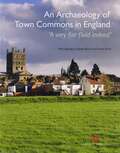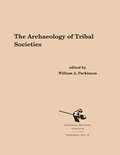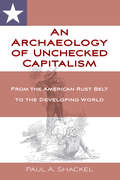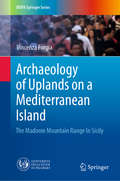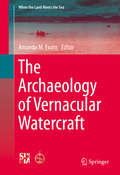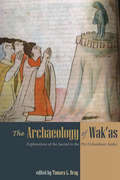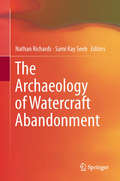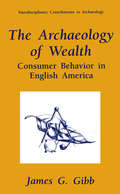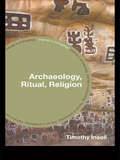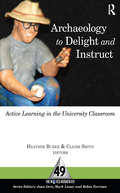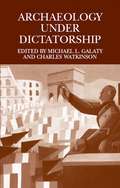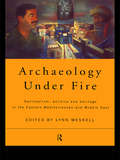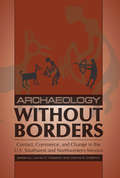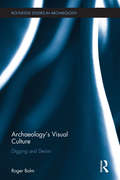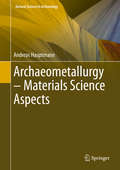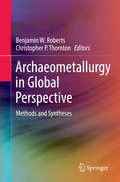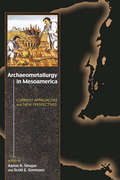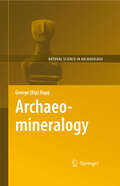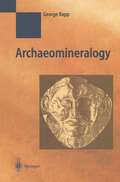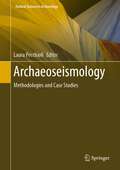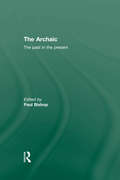- Table View
- List View
An Archaeology of Town Commons in England: 'A very fair field indeed' (English Heritage)
by Mark Bowden Graham Brown Nicky SmithThis is the first published overview of the archaeology of urban common land. By recognising that urban common land represents a valid historical entity, this book contributes towards successful informed conservation. It contains a variety of interesting and illuminating illustrations, including contemporary and archive photographs. Historically, towns in England were provided with common lands for grazing the draft animals of townspeople engaged in trade and for the pasturing of farm animals in an economy where the rural and the urban were inextricably mixed. The commons yielded wood, minerals, fruits and wild animals to the town's inhabitants and also developed as places of recreation and entertainment, as extensions of domestic and industrial space, and as an arena for military, religious and political activities. However, town commons have been largely disregarded by historians and archaeologists; the few remaining urban commons are under threat and are not adequately protected, despite recognition of their wildlife and recreational value. In 2002, English Heritage embarked upon a project to study town commons in England, to match its existing initiatives in other aspects of the urban scene. The aim was to investigate, through a representative sample, the archaeological content and Historic Environment value of urban commons in England and to prompt appropriate conservation strategies for them. The resulting book is the first overview of the archaeology of town commons - a rich resource because of the relatively benign traditional land-use of commons, which preserves the physical evidence of past activities, including prehistoric and Roman remains as well as traces of common use itself. The recognition of town commons as a valid historical entity and a valued part of the modern urban environment is an important first step towards successful informed conservation. An important consideration for the future is maintaining the character of town commons as a different sort of urban open space, distinct from parks and public gardens.
The Archaeology of Tribal Societies (International Monographs in Prehistory: Archaeological Series #15)
Anthropological archaeologists have long attempted to develop models that will let them better understand the evolution of human social organization. In our search to understand how chiefdoms and states evolve, and how those societies differ from egalitarian 'bands', we have neglected to develop models that will aid the understanding of the wide range of variability that exists between them. This volume attempts to fill this gap by exploring social organization in tribal - or 'autonomous village' - societies from several different ethnographic, ethnohistoric, and archaeological contexts - from the Pre-Pottery Neolithic Period in the Near East to the contemporary Jivaro of Amazonia.
An Archaeology of Unchecked Capitalism: From the American Rust Belt to the Developing World
by Paul ShackelThe racialization of immigrant labor and the labor strife in the coal and textile communities in northeastern Pennsylvania appears to be an isolated incident in history. Rather this history can serve as a touchstone, connecting the history of the exploited laborers to today’s labor in the global economy. By drawing parallels between the past and present – for example, the coal mines of the nineteenth-century northeastern Pennsylvania and the sweatshops of the twenty-first century in Bangladesh – we can have difficult conversations about the past and advance our commitment to address social justice issues.
Archaeology of Uplands on a Mediterranean Island: The Madonie Mountain Range In Sicily (UNIPA Springer Series)
by Vincenza ForgiaThis book presents archaeological research conducted within the Highlands of Sicily. Results of an archaeological survey in the Madonie mountain range, in northern Sicily, supported by a chronological and cultural grid, drawn by the excavation of Vallone Inferno, deal with complex and fascinating problems of uplands and mountainous landscape. Settlement patterns, between the Late Pleistocene and the Medieval era, are investigated through the support of spatial analyses. A diversified use of the mountain is currently attested by this research, according to the different prehistoric and historical times. This work is innovative for the Mediterranean area, where there are no similar examples of such extensive territorial research in a mountainous context. The research has been focused on particular aspects of ancient peopling: economic and social issues, human-environment interactions and the long term interest in the mountain range.
The Archaeology of Vernacular Watercraft (When the Land Meets the Sea)
by Amanda M. EvansThis volume presents multiple idiographic, archaeological studies of vernacular watercraft from North America and the Caribbean. Rather than attempt to synthesize all vernacular types, this volume focuses on ship construction data recovered through archaeological investigations that has been used to make inferences about culture. This collection of case studies, including many examples from cultural resource management and graduate student theses, presents a thematic exploration of cultural adaptation as expressed through ship construction.
The Archaeology of Wak'as: Explorations of the Sacred in the Pre-Columbian Andes
by Tamara L. BrayIn this edited volume, Andean wak'as—idols, statues, sacred places, images, and oratories—play a central role in understanding Andean social philosophies, cosmologies, materialities, temporalities, and constructions of personhood. Top Andean scholars from a variety of disciplines cross regional, theoretical, and material boundaries in their chapters, offering innovative methods and theoretical frameworks for interpreting the cultural particulars of Andean ontologies and notions of the sacred. Wak'as were understood as agentive, nonhuman persons within many Andean communities and were fundamental to conceptions of place, alimentation, fertility, identity, and memory and the political construction of ecology and life cycles. The ethnohistoric record indicates that wak'as were thought to speak, hear, and communicate, both among themselves and with humans. In their capacity as nonhuman persons, they shared familial relations with members of the community, for instance, young women were wed to local wak'as made of stone and wak'as had sons and daughters who were identified as the mummified remains of the community's revered ancestors. Integrating linguistic, ethnohistoric, ethnographic, and archaeological data, The Archaeology of Wak'as advances our understanding of the nature and culture of wak'as and contributes to the larger theoretical discussions on the meaning and role of–"the sacred” in ancient contexts.
The Archaeology of Watercraft Abandonment
by Nathan Richards and Sami Kay SeebThe historical importance and archaeological potential of deliberately discarded watercraft has not been a major feature of maritime archaeological enquiry. While research on the topic has appeared since the 1970s as books, chapters, and articles, most examples have been limited in focus and distribution, and in most cases disseminated as unpublished archaeological reports (i.e. the “gray literature”.) So, too, has there been a lack of a single source representing the diversity of geographical, historic, thematic, and theoretical contexts that ships’ graveyard sites and deliberately abandoned vessels represent. In contrast with much of the theoretical or case-specific literature on the theme of watercraft discard, this volume communicates to the reader the common heritage and global themes that ships’ graveyard sites represent. It serves as a blueprint to illustrate how the remains of abandoned vessels in ships' graveyards are sites of considerable research value. Moreover, the case studies in this volume assist researchers in understanding the evolution of maritime technologies, economies, and societies. This volume is intended to expose research potential, create discussion, and reinforce the significance of a prevalent cultural resource that is often overlooked.
The Archaeology of Wealth: Consumer Behavior in English America (Interdisciplinary Contributions to Archaeology)
by James G. GibbJames G. Gibb offers a unique study of 17th century English North American attitudes toward the acquisition and use of wealth. He analyzes domestic sites excavated in Maryland and Virginia to interpret patterns in the construction of household identities and places these patterns within the social and cultural context of the region. His work includes a new critical approach that underscores the role of conscious individual action in history and the importance of material culture in the construction of identities.
Archaeology, Ritual, Religion (Themes in Archaeology Series)
by Timothy InsollThe archaeology of religion is a much neglected area, yet religious sites and artefacts constitute a major area of archaeological evidence. Timothy Insoll presents an introductory statement on the archaeology of religion, examining what archaeology can tell us about religion, the problems of defining and theorizing religion in archaeology, and the methodology, or how to 'do', the archaeology of religion.This volume assesses religion and ritual through a range of examples from around the world and across time, including prehistoric religions, shamanism, African religions, death, landscape and even food. Insoll also discusses the history of research and varying theories in this field before looking to future research directions. This book will be a valuable guide for students and archaeologists, and initiate a major area of debate.
Archaeology, Ritual, Religion (Themes in Archaeology Series)
by Timothy InsollThe archaeology of religion is a much neglected area, yet religious sites and artefacts constitute a major area of archaeological evidence. Timothy Insoll presents an introductory statement on the archaeology of religion, examining what archaeology can tell us about religion, the problems of defining and theorizing religion in archaeology, and the methodology, or how to 'do', the archaeology of religion.This volume assesses religion and ritual through a range of examples from around the world and across time, including prehistoric religions, shamanism, African religions, death, landscape and even food. Insoll also discusses the history of research and varying theories in this field before looking to future research directions. This book will be a valuable guide for students and archaeologists, and initiate a major area of debate.
Archaeology to Delight and Instruct: Active Learning in the University Classroom (One World Archaeology Ser. #49)
by Heather Burke Claire SmithThis book presents novel and interesting ways of teaching archaeological concepts and processes to college and university students. Seeking alternatives to the formal lecture format, the various contributions seek better ways of communicating the complexities of human behavior and of engaging students in active learning about the past. This collection of imaginative exercises designed by 20 master instructors on three continents includes role-playing, games, simulations, activities, and performance, all designed to teach archaeological concepts in interesting and engaging ways.
Archaeology to Delight and Instruct: Active Learning in the University Classroom
by Heather Burke Claire E. SmithThis book presents novel and interesting ways of teaching archaeological concepts and processes to college and university students. Seeking alternatives to the formal lecture format, the various contributions seek better ways of communicating the complexities of human behavior and of engaging students in active learning about the past. This collection of imaginative exercises designed by 20 master instructors on three continents includes role-playing, games, simulations, activities, and performance, all designed to teach archaeological concepts in interesting and engaging ways.
Archaeology Under Dictatorship
by Michael L. Galaty Charles WatkinsonThis volume provides a theoretical basis for understanding the specific effects of totalitarian dictatorship upon the practice of archaeology, both during and after the dictator's reign. The nine essays explore experiences from every corner of the Mediterranean. With its wide-range of case-studies and strong theoretical orientation, this volume is a major advance in the study of the history and politics of archaeology.
Archaeology Under Fire: Nationalism, Politics and Heritage in the Eastern Mediterranean and Middle East
by Lynn MeskellFirst published in 1998. Routledge is an imprint of Taylor & Francis, an informa company.
Archaeology Under Fire: Nationalism, Politics and Heritage in the Eastern Mediterranean and Middle East
by Lynn MeskellFirst published in 1998. Routledge is an imprint of Taylor & Francis, an informa company.
Archaeology without Borders: Contact, Commerce, and Change in the U.S. Southwest and Northwestern Mexico (Proceedings of SW Symposium)
by Eduardo Gamboa Carrera Maxine E. McBrinn Laurie D. WebsterArchaeology without Borders presents new research by leading U.S. and Mexican scholars and explores the impacts on archaeology of the border between the United States and Mexico. Including data previously not readily available to English-speaking readers, the twenty-four essays discuss early agricultural adaptations in the region and groundbreaking archaeological research on social identity and cultural landscapes, as well as economic and social interactions within the area now encompassed by northern Mexico and the U.S. Southwest. Contributors examining early agriculture offer models for understanding the transition to agriculture, explore relationships between the spread of agriculture and Uto-Aztecan migrations, and present data from Arizona, New Mexico, and Chihuahua. Contributors focusing on social identity discuss migration, enculturation, social boundaries, and ethnic identities. They draw on case studies that include diverse artifact classes - rock art, lithics, architecture, murals, ceramics, cordage, sandals, baskets, faunal remains, and oral histories. Mexican scholars present data from Chihuahua, Durango, Zacatecas, Michoacan, Coahuila, and Nuevo Leon. They address topics including Spanish-indigenous conflicts, archaeological history, cultural landscapes, and interactions among Mesoamerica, northern Mexico, and the U.S. Southwest. Laurie D. Webster is a visiting scholar in the Department of Anthropology at the University of Arizona. Maxine E. McBrinn is a postdoctoral research scientist at the Field Museum in Chicago. Proceedings of the 2004 Southwest Symposium. Contributors include Karen R. Adams, M. Nicolás Caretta, Patricia Carot, John Carpenter, Jeffery Clark, Linda S. Cordell, William E. Doolittle, Suzanne L. Eckert, Gayle J. Fritz, Eduardo Gamboa Carrera, Leticia González Arratia, Arturo Guevara Sánchez, Robert J. Hard, Kelly Hays-Gilpin, Marie-Areti Hers, Amber L. Johnson, Steven A. LeBlanc, Patrick Lyons, Jonathan B. Mabry, A. C. MacWilliams, Federico Mancera, Maxine E. McBrinn, Francisco Mendiola Galván, William L. Merrill, Martha Monzón Flores, Scott G. Ortman, John R. Roney, Guadalupe Sanchez de Carpenter, Moisés Valadez Moreno, Bradley J. Vierra, Laurie D. Webster, and Phil C. Weigand.
Archaeology's Visual Culture: Digging and Desire (Routledge Studies in Archaeology)
by Roger BalmArchaeology’s Visual Culture explores archaeology through the lens of visual culture theory. The insistent visuality of archaeology is a key stimulus for the imaginative and creative interpretation of our encounters with the past. Balm investigates the nature of this projection of the visual, revealing an embedded subjectivity in the imagery of archaeology and acknowledging the multiplicity of meanings that cohere around artifacts, archaeological sites and museum displays. Using a wide range of case studies, the book highlights how archaeologists can view objects and the consequences that ensue from these ways of seeing. Throughout the book Balm considers the potential for documentary images and visual material held in archives to perform cultural work within and between groups of specialists. With primary sources ranging from the mid-nineteenth to the early twenty-first century, this volume also maps the intellectual and social connections between archaeologists and their peers. Geographical settings include Britain, Cyprus, Mesoamerica, the Middle East and the United States, and the sites of visual encounter are no less diverse, ranging from excavation reports in salvage archaeology to instrumentally derived data-sets and remote-sensing imagery. By forensically examining selected visual records from published accounts and archival sources, enduring tropes of representation become apparent that transcend issues of style and reflect fundamental visual sensibilities within the discipline of archaeology.
Archaeology's Visual Culture: Digging and Desire (Routledge Studies in Archaeology)
by Roger BalmArchaeology’s Visual Culture explores archaeology through the lens of visual culture theory. The insistent visuality of archaeology is a key stimulus for the imaginative and creative interpretation of our encounters with the past. Balm investigates the nature of this projection of the visual, revealing an embedded subjectivity in the imagery of archaeology and acknowledging the multiplicity of meanings that cohere around artifacts, archaeological sites and museum displays. Using a wide range of case studies, the book highlights how archaeologists can view objects and the consequences that ensue from these ways of seeing. Throughout the book Balm considers the potential for documentary images and visual material held in archives to perform cultural work within and between groups of specialists. With primary sources ranging from the mid-nineteenth to the early twenty-first century, this volume also maps the intellectual and social connections between archaeologists and their peers. Geographical settings include Britain, Cyprus, Mesoamerica, the Middle East and the United States, and the sites of visual encounter are no less diverse, ranging from excavation reports in salvage archaeology to instrumentally derived data-sets and remote-sensing imagery. By forensically examining selected visual records from published accounts and archival sources, enduring tropes of representation become apparent that transcend issues of style and reflect fundamental visual sensibilities within the discipline of archaeology.
Archaeometallurgy – Materials Science Aspects (Natural Science in Archaeology)
by Andreas HauptmannThis book successfully connects archaeology and archaeometallurgy with geoscience and metallurgy. It addresses topics concerning ore deposits, archaeological field evidence of early metal production, and basic chemical-physical principles, as well as experimental ethnographic works on a low handicraft base and artisanal metal production to help readers better understand what happened in antiquity. The book is chiefly intended for scholars and students engaged in interdisciplinary work.
Archaeometallurgy in Global Perspective: Methods and Syntheses
by Benjamin W. Roberts Christopher P. ThorntonThe study of ancient metals in their social and cultural contexts has been a topic of considerable interest in archaeology and ancient history for decades, partly due to the modern dependence on technology and man-made materials. The formal study of Archaeometallurgy began in the 1970s-1980s, and has seen a recent growth in techniques, data, and theoretical movements. This comprehensive sourcebook on Archaeometallurgy provides an overview of earlier research as well as a review of modern techniques, written in an approachable way. Covering an extensive range of archaeological time-periods and regions, this volume will be a valuable resource for those studying archaeology worldwide. It provides a clear, straightforward look at the available methodologies, including:• Smelting processes• Slag analysis• Technical Ceramics• Archaeology of Mining and Field Survey• Ethnoarchaeology• Chemical Analysis and Provenance Studies• Conservation Studies With chapters focused on most geographic regions of Archaeometallurgical inquiry, researchers will find practical applications for metallurgical techniques in any area of their study. Ben Roberts is a specialist in the early metallurgy and later prehistoric archaeology of Europe. He was the Curator of the European Copper and Bronze Age collections at the British Museum between 2007 and 2012 and is now a Lecturer in Prehistoric Europe in the Department of Archaeology at the Durham University, UK. Chris Thornton is a specialist in the ancient metallurgy of the Middle East, combining anthropological theory with archaeometrical analysis to understand the development and diffusion of metallurgical technologies throughout Eurasia. He is currently a Consulting Scholar of the University of Pennsylvania Museum, where he received his PhD in 2009, and the Lead Program Officer of research grants at the National Geographic Society.
Archaeometallurgy in Mesoamerica: Current Approaches and New Perspectives
by Aaron N. Shugar Scott E. SimmonsPresenting the latest in archaeometallurgical research in a Mesoamerican context, Archaeometallurgy in Mesoamerica brings together up-to-date research from the most notable scholars in the field. These contributors analyze data from a variety of sites, examining current approaches to the study of archaeometallurgy in the region as well as new perspectives on the significance metallurgy and metal objects had in the lives of its ancient peoples. The chapters are organized following the cyclical nature of metals--beginning with extracting and mining ore, moving to smelting and casting of finished objects, and ending with recycling and deterioration back to the original state once the object is no longer in use. Data obtained from archaeological investigations, ethnohistoric sources, ethnographic studies, along with materials science analyses, are brought to bear on questions related to the integration of metallurgy into local and regional economies, the sacred connotations of copper objects, metallurgy as specialized crafting, and the nature of mining, alloy technology, and metal fabrication.
Archaeomineralogy (Natural Science in Archaeology)
by George Rapp“Archaeomineralogy” provides a wealth of information for mineralogists, geologists and archaeologists involved in archaeometric studies. The first edition was very well-received and praised for its systematic description of the rocks and minerals used throughout the world by our ancestors and for its excellent list of over 900 references, providing easy access to the fields of archaeomineralogy and geoarchaeology.This second edition of “Archaeomineralogy” takes an updated and expanded look at the human use of rocks and minerals from the Paleolithic through to the 18th century CE. It retains the structure and main themes of the original but has been revised and expanded with more than 200 new references within the text, a bibliography of additional references not included in the text, a dozen new figures (drawings and photos), coverage of many additional important mineral, rock, and gem materials, a broader geographic scope, particularly but not limited to Eastern Europe, and a more thorough review of early contributions to archaeomineralogy, especially those of Agricola. From reviews of the first edition:"… crammed full of useful information, is well-balanced using both new and Old World examples of the archaeomaterials described. It also provides a broad, but of necessity, all too brief overview of the geological raw materials used in antiquity." -- Geoscientist "…provides much interesting discussion of how particular names came to be employed by archaeologists working in different regions of the world…. much to offer for any geologist or archaeologist interested in minerals and rocks and how they have been used in the past." -- Mineralium Deposita"… a gem of a book, it's strength is that it is encyclopedic in content, if not in layout, draws on a wealth of field experience and almost every sentence contains a nugget of information" -- The Holocene
Archaeomineralogy (Natural Science in Archaeology)
by George R. Rapp1.1 Prologue What is archaeomineralogy? The term has been used at least once before (Mitchell 1985), but this volume is the first publication to lay down the scientific basis and systematics for this subdiscipline. Students sometimes call an introductory archaeology course "stones and bones." Archaeomineralogy covers the stones component of this phrase. Of course, archaeology consists of a great deal more than just stones and bones. Contemporary archaeology is based on stratigraphy, geomorphology, chronometry, behavioral inferences, and a host of additional disciplines in addition to those devoted to stones and bones. To hazard a definition: archaeomineralogy is the study of the minerals and rocks used by ancient societies over space and time, as implements, orna ments, building materials, and raw materials for ceramics and other processed products. Archaeomineralogy also attempts to date, source, or otherwise char acterize an artifact or feature, or to interpret past depositional alteration of archaeological contexts. Unlike geoarchaeology, archaeomineralogy is not, and is not likely to become, a recognized subdiscipline. Practitioners of archaeomineralogy are mostly geoarchaeologists who specialize in geology and have a strong background in mineralogy or petrology (the study of the origin ofrocks).
Archaeoseismology: Methodologies and Case Studies (Natural Science in Archaeology)
by Laura PecchioliArchaeoseismic research provides data and information on past earthquakes but is limited by the lack of ongoing discussions about methodology. This volume is an interdisciplinary approach including archaeologists, geologists, geophysicists, seismologists, engineers, and architects from different countries to present a comprehensive recording and interpretation of ancient natural disasters on some case studies. The publication is an introduction to various aspects of the field of archaeoseismology for the knowledge of past seismicity, the reconstruction of the chronological history of a place, the interpretation and identification of seismic effects using different methods, etc. The collection provides an overview of research into archaeoseismology, making new contributions through innovative ideas on various topics. The publication can be an illustrative introduction to better understand the complexity of interpreting seismic effects on ancient and modern masonries, particularly for students with an open mind.
The Archaic: The Past in the Present
by Paul BishopThe Archaic takes as its major reference points C.G. Jung's classic essay, 'Archaic Man' (1930), and Ernesto Grassi's paper on 'Archaic Theories of History' (1990). Moving beyond the confines of a Jungian framework to include other methodological approaches, this book explores the concept of the archaic. Defined as meaning 'old-fashioned', 'primitive', 'antiquated', the archaic is, in fact, much more than something very, very old: it is timeless, inasmuch as it is before time itself. Archē, Urgrund, Ungrund, 'primordial darkness', 'eternal nothing' are names for something essentially nameless, yet whose presence we nevertheless intuit. This book focuses on the reception of myth in the tradition of German Idealism or Romanticism (Creuzer, Schelling, Nietzsche), which not only looked back to earlier thinkers (such as Jacob Boehme) but also laid down roots for developments in twentieth-century thought (Ludwig Klages, Martin Heidegger). The Archaic also includes: studies of the Germanic dimension of the archaic (Charles Bambach, Alan Cardew) a discussion of the mytho-phenomenological approach to the archaic (Robert Josef Kozljanič) a series of articles on Jung's understanding of the archaic (Paul Bishop, Susan Rowland, Robert Segal). This book will be of interest to psychoanalysts, anthropologists and phenomenologists, as well as students of psychology, cultural studies, religious studies, and philosophy, as it seeks to rehabilitate a concept of demonstrable and urgent relevance for our time.
